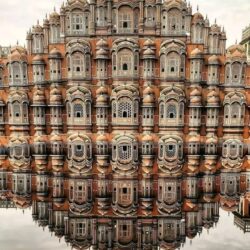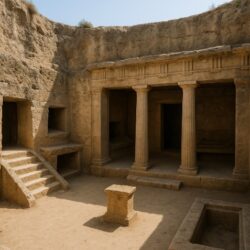The Rampuria Haveli in Bikaner, Rajasthan, stands as a testament to the grandeur of India’s architectural legacy. With intricate craftsmanship, opulent decor, and a timeless aura, this heritage structure reflects the unique blend of traditional Rajputana culture and artistic brilliance. Let’s delve into its fascinating details.
A Historical Treasure in Bikaner
Built in the late 19th century by the wealthy Rampuria family, the haveli is often referred to as the “Pride of Bikaner.” Its construction symbolizes the prosperity of the family during Bikaner’s flourishing trading era. The havelis were designed as luxurious residences, combining practical utility with aesthetic beauty.

Architectural Marvels of Rampuria Haveli
1. Red Sandstone Facade
The Rampuria Haveli is primarily constructed using red sandstone from Dulmera, a material known for its durability and striking appearance. The earthy tones blend seamlessly with the arid desert landscape of Rajasthan, creating a striking contrast against the azure sky.
2. Intricate Carvings
The haveli’s facade is adorned with elaborate carvings, including:
- Jharokhas (overhanging balconies): These intricately carved balconies are not only a visual delight but also a reflection of Rajasthani aesthetics.
- Floral motifs and latticework: Representing artistic precision, these designs symbolize cultural and spiritual significance.
3. Grand Doorways and Windows
The doorways and windows are masterpieces of woodwork, often featuring:
- Golden-hued brass inlays
- Marble detailing
- Intricate engravings that narrate mythological stories and local folklore.
4. Courtyards and Layout
The haveli’s interiors are arranged around a central courtyard, an essential feature for ventilation and light in desert climates. The layout ensured the family’s privacy while fostering communal living.
Cultural and Artistic Significance
Rampuria Haveli is not just an architectural gem but also a cultural repository. It reflects the traditional lifestyle, taste, and wealth of the merchants who once inhabited it. The interiors are lavishly decorated with:
- Venetian glass panels
- Vintage chandeliers
- Exquisite frescoes
- European-style furniture, showcasing a confluence of local and global design sensibilities.
Rampuria Haveli in Modern Times
While it remains a privately owned property, the haveli is a must-see attraction for tourists and architecture enthusiasts. Its picturesque charm makes it a favorite backdrop for photography and a window into the lifestyle of Rajasthan’s aristocracy.
How to Visit Rampuria Haveli
Located in the heart of old Bikaner, the haveli is accessible via:
- Air: Bikaner Airport (nearest major airport: Jodhpur)
- Rail: Bikaner Junction, with connections to major cities.
- Road: Well-connected through national highways.
The best time to visit is during the cooler months, from October to March, to enjoy the city’s desert climate comfortably.
Preserving Heritage: Challenges and Efforts
Preserving structures like Rampuria Haveli is critical for safeguarding cultural heritage. Restoration projects and government initiatives aim to maintain the haveli’s grandeur while promoting tourism.
Conclusion
Rampuria Haveli is a timeless icon of Bikaner, embodying the architectural prowess and cultural richness of Rajasthan. A visit to this marvel is akin to stepping back in time, offering an unforgettable glimpse into the opulence of India’s bygone era.



















